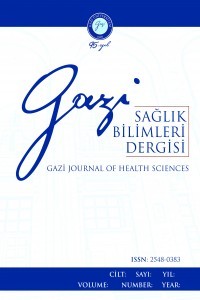Üst ekstremite hipermobilite değerlendirme skorunun (the upper limb hypermobility assessment tool) değerlendiriciler arası güvenilirliği
Genel eklem hipermobilitesi, en az dört eklemde ve en az bir hareket düzleminde normalden daha fazla pasif ve aktif hareket açıklığı ile karakterize asemptomatik bir durumdur. Literatürde hipermobil bireylerin azalmış fiziksel performansa, zayıf eklem propriosepsiyonuna ve kas güçsüzlüğüne sahip oldukları belirtilmektedir. Bu durumun hipermobil bireylerde yaralanma veya sakatlık riskini arttırdığı düşünülmektedir. Literatürde Beighton skorunun, hipermobiliteyi belirlemek için en sık kullanılan skorlama yöntemi olmasına rağmen özellikle üst ekstremitelerin hipermobilitesini belirlemek için yetersiz kaldığı belirtilmektedir. Bu çalışmanın amacı üst ekstremite hipermobilite değerlendirme skorunu değerlendiriciler arası güvenilirliğinin araştırılmasıydı. Çalışma, Kütahya Sağlık Bilimleri Üniversitesi Sağlık Bilimleri Fakültesinde Ağustos-Ekim 2022 arasında, kesitsel tanımlayıcı bir çalışma olarak gerçekleştirildi. Katılımcılara üst ekstremitelerin hipermobilitesini değerlendiren 12 maddelik test, 2 değerlendirici tarafından birer kez uygulandı. Katılımcıların sırasıyla sol üst ekstremite, sağ üst ekstremite ve total (sol + sağ) skorları kaydedildi. Elde edilen veriler SPSS 22 paket istatistik programında değerlendirildi. Çalışmaya sağlıklı 65 kadın, 23 erkek (yaş 21,93 ±3.98 yıl) katılımcı alındı. Katılımcıların %93’ünün dominant tarafı sağ iken, % 7’si sol dominanttı. Üst ekstremite hipermobilite değerlendirme skorunun değerlendiriciler arası tutarlılığı katsayısı (ICC) sol üst ekstremite, sağ üst ekstremite ve total skorlarda yüksek bulundu (sırasıyla ICC1=0.838, ICC2=0.893, ICC3=0.903). Üst Ekstremite Hipermobilite Değerlendirme Skoru üst ekstremite eklemlerinin fizyolojik, aksesuar ve aktif hareketlerini tüm hareket düzlemlerinde değerlendirdiği için Beighton skoruna göre daha detaylı ve hassas sonuçlar sağlayabilir.
Anahtar Kelimeler:
hipermobilite, üst ekstremite, beighton skoru, üst ekstremite hipermobilite değerlendirme skoru
Inter-rater reliability of the upper limb hypermobility assessment tool
Generalized joint hypermobility is an asymptomatic condition characterized by greater than normal passive and active range, in at least four joints and in at least one plane of motion. In the literature, it is stated that hypermobile individuals have decreased physical performance, poor joint proprioception and muscle weakness. This is thought to increase the risk of injury in hypermobile individuals. Although the Beighton score is the most commonly used scoring method to determine hypermobility in the literature, it is stated that it is insufficient to determine hypermobility of the upper extremities. The aim of this study was to investigate the inter-rater reliability of The Upper Limb Hypermobility Assessment Tool. The study was carried out as a cross-sectional descriptive study between August and October 2022 at the Faculty of Health Sciences of Kutahya Health Sciences University. The 12-item test evaluating the hypermobility of the upper extremities was administered to the participants once by 2 evaluators. Left upper extremity, right upper extremity and total (left + right) scores of the participants were recorded, respectively. The obtained data were evaluated in SPSS 22 package statistics program. 88 healty volunteers (65 women and 23 men, age 21,93 ±3.98 years) participated in the study. While 93% of the participants were right-hand dominant, 7% were left-hand dominant. Intraclass correlation coefficient (ICC) of The Upper Limb Hypermobility Assessment Tool was high in left upper extremity, right upper extremity and total scores (ICC1=0.838, ICC2=0.893, ICC3=0.903, respectively). The Upper Limb Hypermobility Assessment Tool can provide more detailed and sensitive results compared to the Beighton score, since it evaluates the physiological, accessory and active movements of the upper extremity joints in all motion planes.
Keywords:
hypermobility, upper extremity, beighton score, the upper limb hypermobility assessment tool,
___
- 7. Ulusal Romatolojik Rehabilitasyon Kongresi bildirisidir.
- ISSN: 2548-0383
- Yayın Aralığı: Yılda 3 Sayı
- Başlangıç: 2015
- Yayıncı: Gazi Üniversitesi
Sayıdaki Diğer Makaleler
Skleroderma Hastalarında Gastrointestinal Sistem Tutulumu, Beslenme ve Yutma
Emrah AFŞAR, İsmail SARAÇOĞLU, Merve YERLİKAYA
Farklı ağrı şiddetlerinin fibromiyalji sendromu olan bireylerdeki etkisinin incelenmesi
Esra AKIN, İsmail SARACOGLU, Merve AKDENİZ
Sinem ÖZGÜL, Özgül ÖZTÜRK, Arif GÜLKESE
Erişkin dönemi romatolojik hastalıklarda rehabilitasyon yönetimi
Aksiyel spondiloartritli bireylerde kırılganlık durumunun üç farklı yöntem ile belirlenmesi
Özgül ÖZTÜRK, Özlem FEYZİOĞLU, Fatih SARITAŞ
